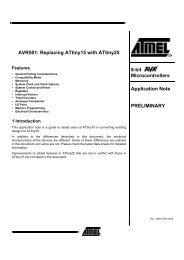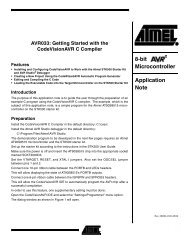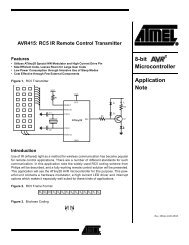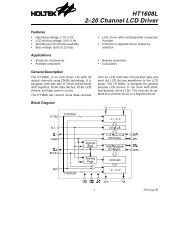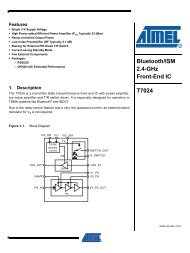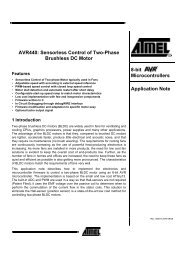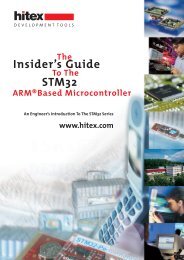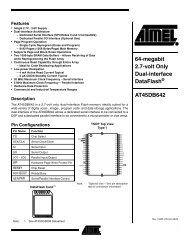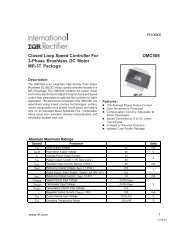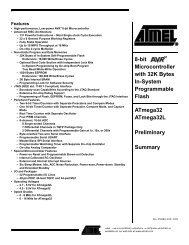Preliminary C8051F120/1/2/3 C8051F124/5/6/7 - KEMT FEI TUKE
Preliminary C8051F120/1/2/3 C8051F124/5/6/7 - KEMT FEI TUKE
Preliminary C8051F120/1/2/3 C8051F124/5/6/7 - KEMT FEI TUKE
You also want an ePaper? Increase the reach of your titles
YUMPU automatically turns print PDFs into web optimized ePapers that Google loves.
<strong>Preliminary</strong><br />
<strong>C8051F120</strong>/1/2/3<br />
<strong>C8051F124</strong>/5/6/7<br />
12.2.2. Data Memory<br />
The CIP-51 implements 256 bytes of internal RAM mapped into the data memory space from 0x00 through 0xFF.<br />
The lower 128 bytes of data memory are used for general purpose registers and memory. Either direct or indirect<br />
addressing may be used to access the lower 128 bytes of data memory. Locations 0x00 through 0x1F are addressable<br />
as four banks of general purpose registers, each bank consisting of eight byte-wide registers. The next 16 bytes, locations<br />
0x20 through 0x2F, may either be addressed as bytes or as 128 bit locations accessible with the direct addressing<br />
mode.<br />
The upper 128 bytes of data memory are accessible only by indirect addressing. This region occupies the same<br />
address space as the Special Function Registers (SFR) but is physically separate from the SFR space. The addressing<br />
mode used by an instruction when accessing locations above 0x7F determines whether the CPU accesses the upper<br />
128 bytes of data memory space or the SFR’s. Instructions that use direct addressing will access the SFR space.<br />
Instructions using indirect addressing above 0x7F access the upper 128 bytes of data memory. Figure 12.2 illustrates<br />
the data memory organization of the CIP-51.<br />
12.2.3. General Purpose Registers<br />
The lower 32 bytes of data memory, locations 0x00 through 0x1F, may be addressed as four banks of general-purpose<br />
registers. Each bank consists of eight byte-wide registers designated R0 through R7. Only one of these banks may be<br />
enabled at a time. Two bits in the program status word, RS0 (PSW.3) and RS1 (PSW.4), select the active register bank<br />
(see description of the PSW in Figure 12.18). This allows fast context switching when entering subroutines and interrupt<br />
service routines. Indirect addressing modes use registers R0 and R1 as index registers.<br />
12.2.4. Bit Addressable Locations<br />
In addition to direct access to data memory organized as bytes, the sixteen data memory locations at 0x20 through<br />
0x2F are also accessible as 128 individually addressable bits. Each bit has a bit address from 0x00 to 0x7F. Bit 0 of<br />
the byte at 0x20 has bit address 0x00 while bit 7 of the byte at 0x20 has bit address 0x07. Bit 7 of the byte at 0x2F has<br />
bit address 0x7F. A bit access is distinguished from a full byte access by the type of instruction used (bit source or<br />
destination operands as opposed to a byte source or destination).<br />
The MCS-51 assembly language allows an alternate notation for bit addressing of the form XX.B where XX is the<br />
byte address and B is the bit position within the byte. For example, the instruction:<br />
MOV C, 22.3h<br />
moves the Boolean value at 0x13 (bit 3 of the byte at location 0x22) into the Carry flag.<br />
12.2.5. Stack<br />
A programmer's stack can be located anywhere in the 256 byte data memory. The stack area is designated using the<br />
Stack Pointer (SP, address 0x81) SFR. The SP will point to the last location used. The next value pushed on the stack<br />
is placed at SP+1 and then SP is incremented. A reset initializes the stack pointer to location 0x07; therefore, the first<br />
value pushed on the stack is placed at location 0x08, which is also the first register (R0) of register bank 1. Thus, if<br />
more than one register bank is to be used, the SP should be initialized to a location in the data memory not being used<br />
for data storage. The stack depth can extend up to 256 bytes.<br />
The MCUs also have built-in hardware for a stack record which is accessed by the debug logic. The stack record is a<br />
32-bit shift register, where each PUSH or increment SP pushes one record bit onto the register, and each CALL<br />
pushes two record bits onto the register. (A POP or decrement SP pops one record bit, and a RET pops two record<br />
bits, also.) The stack record circuitry can also detect an overflow or underflow on the 32-bit shift register, and can<br />
notify the debug software even with the MCU running at speed.<br />
© 2002 Cygnal Integrated Products, Inc. DS008-0.8-AUG02 Page 125



